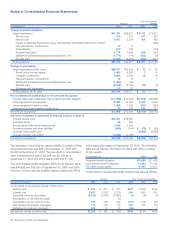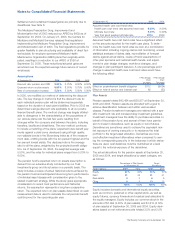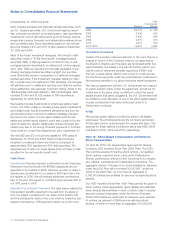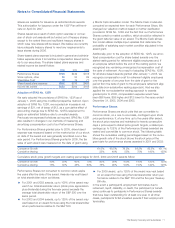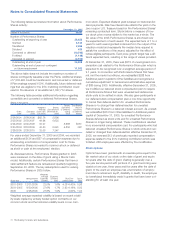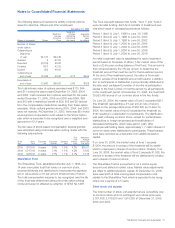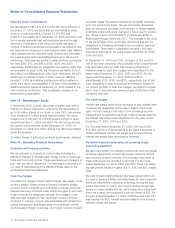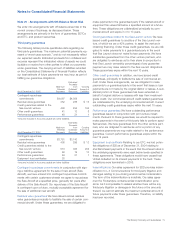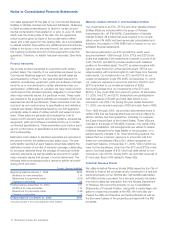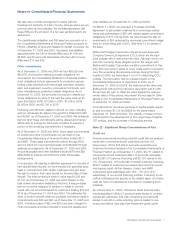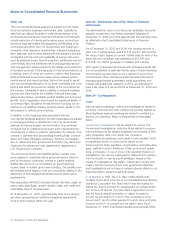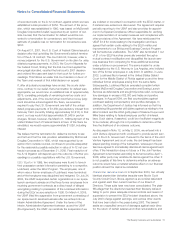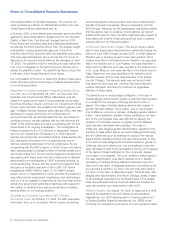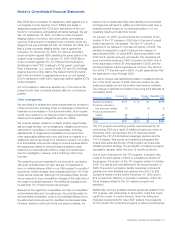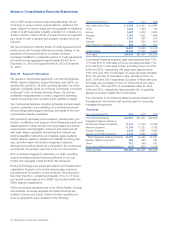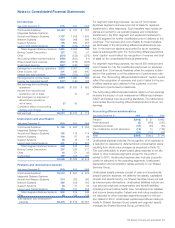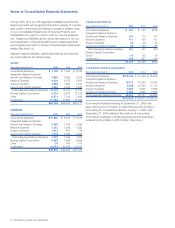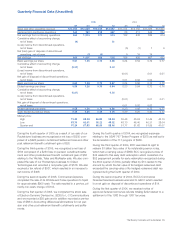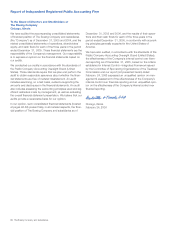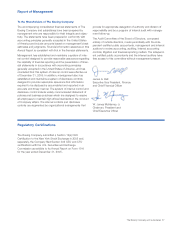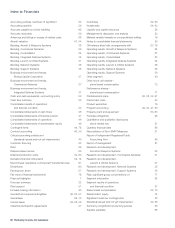Boeing 2005 Annual Report Download - page 80
Download and view the complete annual report
Please find page 80 of the 2005 Boeing annual report below. You can navigate through the pages in the report by either clicking on the pages listed below, or by using the keyword search tool below to find specific information within the annual report.Notes to Consolidated Financial Statements
Other risk
The Commercial Airplanes segment is subject to both opera-
tional and external business environment risks. Operational
risks that can disrupt its ability to make timely delivery of its
commercial jet aircraft and meet its contractual commitments
include execution of internal performance plans, product per-
formance risks associated with regulatory certifications of its
commercial aircraft by the U.S. Government and foreign gov-
ernments, other regulatory uncertainties, collective bargaining
labor disputes, performance issues with key suppliers and sub-
contractors and the cost and availability of energy resources,
such as electrical power. Aircraft programs, particularly new air-
craft models, face the additional risk of pricing pressures and
cost management issues inherent in the design and production
of complex products. Financing support may be provided by us
to airlines, some of which are unable to obtain other financing.
External business environment risks include adverse govern-
mental export and import policies, factors that result in signifi-
cant and prolonged disruption to air travel worldwide and other
factors that affect the economic viability of the commercial air-
line industry. Examples of factors relating to external business
environment risks include the volatility of aircraft fuel prices,
global trade policies, worldwide political stability and economic
growth, acts of aggression that impact the perceived safety of
commercial flight, escalation trends inherent in pricing our air-
craft and a competitive industry structure which results in mar-
ket pressure to reduce product prices.
In addition to the foregoing risks associated with the
Commercial Airplanes segment, the IDS businesses are subject
to changing priorities or reductions in the U.S. Government
defense and space budget, and termination of government
contracts due to unilateral government action (termination for
convenience) or failure to perform (termination for default). Civil,
criminal or administrative proceedings involving fines, compen-
satory and treble damages, restitution, forfeiture and suspen-
sion or debarment from government contracts may result from
violations of business and cost classification regulations on
U.S. Government contracts.
The commercial launch and satellite service markets have
some degree of uncertainty since global demand is driven in
part by the launch customers’ access to capital markets.
Additionally, some of our competitors for launch services
receive direct or indirect government funding. The satellite mar-
ket includes some degree of risk and uncertainty relating to the
attainment of technological specifications and performance
requirements.
Risk associated with BCC includes interest rate risks, asset val-
uation risks, specifically, aircraft valuation risks, and credit and
collectibility risks of counterparties.
As of December 31, 2005, approximately 36% of our employ-
ees were represented by collective bargaining agreements,
none of which expires within one year.
Note 23 - Disclosures about Fair Value of Financial
Instruments
The estimated fair value of our Accounts receivable, Accounts
payable, Investments, and Notes receivable balances at
December 31, 2005 and 2004 approximate their carrying value
as reflected in the Consolidated Statements of Financial
Position.
As of December 31, 2005 and 2004, the carrying amount of
debt, net of capital leases, was $10,516 and $11,884 and the
fair value of debt, based on current market rates for debt of the
same risk and maturities, was estimated at $11,643 and
$13,198. Our debt is generally not callable until maturity.
With regard to financial instruments with off-balance sheet risk,
it is not practicable to estimate the fair value of future financing
commitments because there is not a market for such future
commitments. Other off-balance sheet financial instruments,
including asset-related guarantees, credit guarantees, and
interest rate guarantees related to an ETC, are estimated to
have a fair value of $148 and $165 at December 31, 2005 and
2004.
Note 24 - Contingencies
Legal
Various legal proceedings, claims and investigations related to
products, contracts and other matters are pending against us.
Most significant legal proceedings are related to matters cov-
ered by our insurance. Major contingencies are discussed
below.
Government investigations We are subject to various U.S.
Government investigations, including those related to procure-
ment activities and the alleged possession and misuse of third-
party proprietary data, from which civil, criminal or
administrative proceedings could result or have resulted. Such
proceedings involve, or could involve claims by the
Government for fines, penalties, compensatory and treble dam-
ages, restitution and/or forfeitures. Under government regula-
tions, a company, or one or more of its operating divisions or
subdivisions, can also be suspended or debarred from govern-
ment contracts, or lose its export privileges, based on the
results of investigations. We believe, based upon current infor-
mation, that the outcome of any such government disputes
and investigations will not have a material adverse effect on our
financial position, except as set forth below.
A-12 litigation In 1991, the U.S. Navy notified McDonnell
Douglas Corporation (now one of our subsidiaries) and General
Dynamics Corporation (the Team) that it was terminating for
default the Team’s contract for development and initial produc-
tion of the A-12 aircraft. The Team filed a legal action to con-
test the Navy’s default termination, to assert its rights to
convert the termination to one for “the convenience of the
Government,” and to obtain payment for work done and costs
incurred on the A-12 contract but not paid to date. As of
December 31, 2005, inventories included approximately $584
78 The Boeing Company and Subsidiaries


